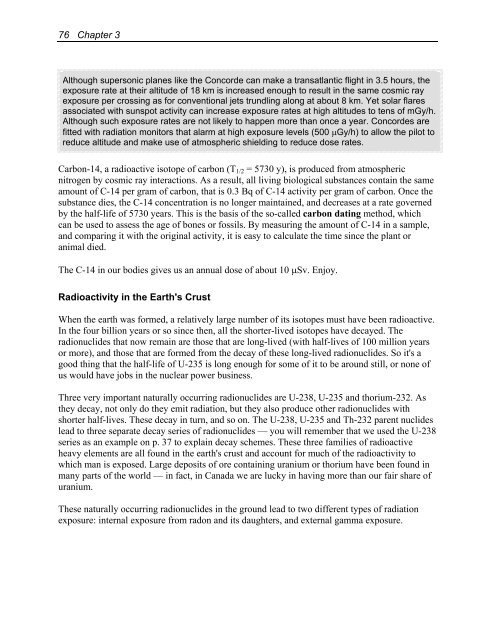CHAPTER 3 RADIATION DOSE
CHAPTER 3 RADIATION DOSE
CHAPTER 3 RADIATION DOSE
You also want an ePaper? Increase the reach of your titles
YUMPU automatically turns print PDFs into web optimized ePapers that Google loves.
76 Chapter 3Although supersonic planes like the Concorde can make a transatlantic flight in 3.5 hours, theexposure rate at their altitude of 18 km is increased enough to result in the same cosmic rayexposure per crossing as for conventional jets trundling along at about 8 km. Yet solar flaresassociated with sunspot activity can increase exposure rates at high altitudes to tens of mGy/h.Although such exposure rates are not likely to happen more than once a year. Concordes arefitted with radiation monitors that alarm at high exposure levels (500 µGy/h) to allow the pilot toreduce altitude and make use of atmospheric shielding to reduce dose rates.Carbon-14, a radioactive isotope of carbon (T 1/2 = 5730 y), is produced from atmosphericnitrogen by cosmic ray interactions. As a result, all living biological substances contain the sameamount of C-14 per gram of carbon, that is 0.3 Bq of C-14 activity per gram of carbon. Once thesubstance dies, the C-14 concentration is no longer maintained, and decreases at a rate governedby the half-life of 5730 years. This is the basis of the so-called carbon dating method, whichcan be used to assess the age of bones or fossils. By measuring the amount of C-14 in a sample,and comparing it with the original activity, it is easy to calculate the time since the plant oranimal died.The C-14 in our bodies gives us an annual dose of about 10 µSv. Enjoy.Radioactivity in the Earth's CrustWhen the earth was formed, a relatively large number of its isotopes must have been radioactive.In the four billion years or so since then, all the shorter-lived isotopes have decayed. Theradionuclides that now remain are those that are long-lived (with half-lives of 100 million yearsor more), and those that are formed from the decay of these long-lived radionuclides. So it's agood thing that the half-life of U-235 is long enough for some of it to be around still, or none ofus would have jobs in the nuclear power business.Three very important naturally occurring radionuclides are U-238, U-235 and thorium-232. Asthey decay, not only do they emit radiation, but they also produce other radionuclides withshorter half-lives. These decay in turn, and so on. The U-238, U-235 and Th-232 parent nuclideslead to three separate decay series of radionuclides — you will remember that we used the U-238series as an example on p. 37 to explain decay schemes. These three families of radioactiveheavy elements are all found in the earth's crust and account for much of the radioactivity towhich man is exposed. Large deposits of ore containing uranium or thorium have been found inmany parts of the world — in fact, in Canada we are lucky in having more than our fair share ofuranium.These naturally occurring radionuclides in the ground lead to two different types of radiationexposure: internal exposure from radon and its daughters, and external gamma exposure.
















